How To Trigger Flash Off Camera
Six Ways to Become Wireless With Your Flash

A big step in my progression with DSLR photography was finally getting an external wink, the adjacent step was getting that flash off my photographic camera and doing and so wirelessly. In this post, I'll talk about the myriad of options for going wireless with an external flash. There's pros and cons for each selection of course. Some are free while others tin price equally much as your camera.
An external flash is commonly known as a Speedlite (Canon) / Speedlight (Nikon) and information technology's designed to be put correct on pinnacle of your camera in the flash "hot shoe". Present, however, an external flash forms part of a complex and highly integrated system. It'southward an intelligent lite source full of software and electronics that securely integrate with your camera.
Then why was an external flash such a big pace? As before long as I began to control lite, I began to create the shots I wanted vs. just recording what was in front of me. It forced me to really sympathize exposure and make artistic decisions about light (e.g. mixing intensity, direction, spread, and other qualities of calorie-free).
At offset, I started with the flash firmly planted on my photographic camera. Quickly I tired of flat on-axis light and so I learned how to effectively bounciness my wink off ceilings and walls. One great technique I learned was how avoid direct low-cal hitting the subject (see instance).
However, I knew the adjacent major step was to utilise the flash off my camera. It would let me to produce directional calorie-free without bouncing the lite off another surface and I would gain tremendous creative freedom. In fact, since I was no longer restricted to the single flash shoe on my camera, I started considering multiple flash units being fired simultaneously. I have 2 flashes now (a 580EX Ii and a 430EX II).
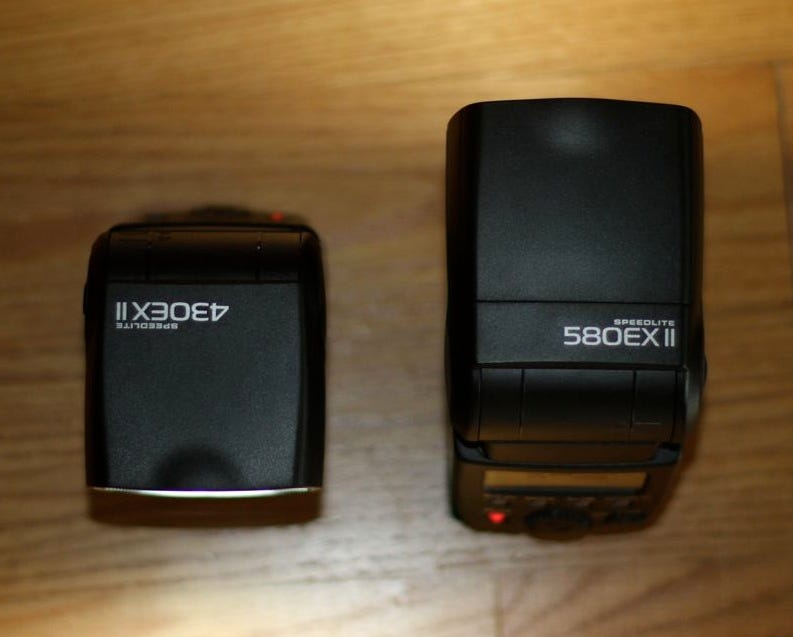
The questions became…
- "How practice I trigger a flash while information technology's not on my camera?"
- "How tin I avoid crazy long wires?" and,
- "How practice I control multiple flash units at the aforementioned time?"
These's unfortunately few straightforward answers just the good news is in that location are many options available — all of which I've detailed for you lot in this post.
Flash 101: TTL vs. Manual Flash
Before I get into the discussion about remotely triggering a flash, it's important to notation that there are ii distinct ways to control a flash (wired or wireless). In essence, you can either have the camera piece of work in concert with the flash to set the correct power level or you lot can gear up the power level manually.
The automated fashion is referred to as "TTL" (Canon calls information technology "E-TTL" and Nikon calls it "i-TTL") and it's short for "Through the Lens". In this manner, your flash and camera communicate in real-fourth dimension to regulate the ability of the wink without yous even noticing.
While in TTL mode, your flash fires an extra flare-up of calorie-free a split-second earlier the "real" wink. This pre-flash bounces off your subject and back into the photographic camera via the lens (hence "through the lens"). Your camera instantly evaluates if you need more or less light and adjusts the wink ability appropriately. It does that extra step then fast that yous simply perceive a unmarried burst of low-cal (information technology's hugely impressive).
As you can imagine, transmission wink doesn't make use of any pre-wink or fancy camera evaluation. You simply tell the flash to fire at its full power, 1/2 power, 1/4, ability, etc. and it uses that strength consistently from shot to shot.
Calculating the required wink ability, nonetheless, tin be tricky. You have to memorize your flash's power rating (its "guide number") and practise some mental math equally information technology relates to your flash's position relative to the subject being lit.
Automatic TTL mode is a real time-saver when the distance from you subject and the flash is ever changing. You don't have to summate and or re-test your flash power on every shot. If the flash-to-discipline distance won't vary between shots, you might really prefer a manual flash setting as you'll go a consistent exposure beyond a series of shots.
I'thou highlighting these differences now as some options for triggering your off-camera flash will remove your power to shoot in TTL mode.
OK, plenty background and onto your options for getting your flash off the camera with equally few wires equally possible.
Option one: Congenital-in Camera-to-Wink Wireless Trigger
If you have a Canon 7D, 60D or T3i, you're in luck equally you take a built-in remote wink trigger. If you lot have the Nikon D40 or meliorate, you probably have 1 besides.
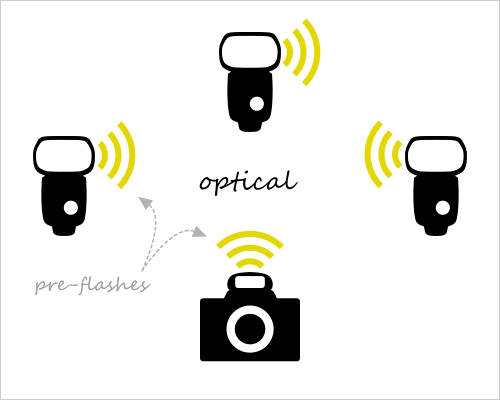
Nikon refers to its wireless flash capability as beingness part of their "Artistic Lighting Organization". Catechism hasn't got a fancy name for information technology merely they're pretty much the same (Wikipedia: Canon EOS Flash System).
Naturally, if yous take this capability in your camera and ain a uniform flash unit of measurement, you'll want to start here as this is effectively gratis and it works reasonably well.
That said, I have a Catechism 7D and have used the Canon organisation extensively and I encountered a variety of issues. Information technology'southward a huge step forward but at that place are some serious downsides which may push you to consider alternatives as I did.
For these built-in systems to function, your camera uses its pop-upward flash as a transmitter. The camera is referred to as the "master" or "commander" which controls "slave" or "remote" flashes.
With this pick, you set all the flash options directly in your camera'southward flash menu and you tin can get to utilise every single TTL capability offered without a single wire. You lot can also ready manual flash power levels from the photographic camera as well.
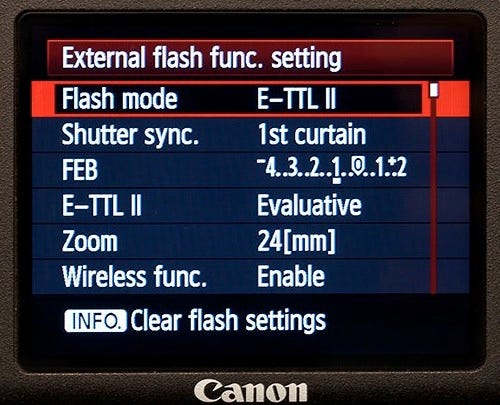
Both Canon and Nikon let you to control three flash groups labeled A, B and C. Within these groups, you tin trigger a near-unlimited number of flashes. The benefit of groups is the power to have varying levels of power. You can even set them upwards with ratios (e.g. 2:1 for groups A:B so your key light is twice a strong as your fill light).
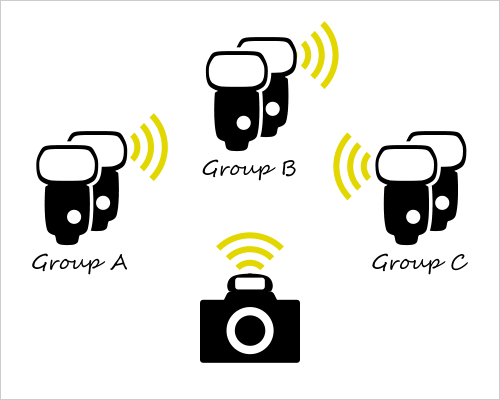
The biggest issue with this pick is that the indicate from camera to the flash is optical and not radio-based. Even your cordless phone and garage opener apply more reliable radio-waves. Instead, these systems employ bursts of low-cal from your pop-upward flash or infrared (IR) signals. This is more akin to your Tv set remote command. Such transmissions can exist inconsistent as they crave line-of-sight and can be afflicted past other light sources. The range is also limited to near xxx feet.
UPDATE September 14, 2012: Joe McNally recently created a video demonstrating a test using only the Nikon D800'due south pop-up flash in brilliant sunlight and was able to trigger a SB-900 from 100 feet away! That was impressive. If yous have 2 flashes to fire and can't exercise perfect line-of-sight, you can look that distance to be decreased.
When yous're indoors, you don't really need line-of-sight as these signals will bounce off the walls and ceiling. If you're outdoors, nevertheless, the transmitting part of the camera and the receiver on the flash actually need to see each other. This tin can be limiting as you might turn y'all camera to shoot in portrait orientation and then lose the connection to your flash.
What's worse, bright sunlight can finer wash-out the pop-up flash or IR signal. Yous may have line-of-sight but will find your wink simply doesn't burn or fires inconsistently.
Some other disadvantage that'south far less discussed is that your camera'south pop-up wink can quickly overheat. Even when it's non set to contribute real light to scene, my pop-upward flash on the Canon 7D forces my camera to study "Decorated" while it cools down. It prevents me from taking another photo for 10 to 20 seconds at a fourth dimension.
This is especially frustrating as I'thou non request the popular-upwardly flash to fire at full forcefulness. My external wink units take no outcome and recycle rapidly. They sit in that location idle as I miss shot afterwards shot of my kids. No one told me that the pop-up flash can overheat like that, it's something I had to notice on my own.
For all these reasons, radio-based triggering is preferred which is why Canon released information technology'south latest Speedlite (600EX-RT) with a radio trigger. It's not the well-nigh affordable option but I was edifice out a dream setup, I'd own iii or four of those and be all prepare. Given a $1200 to $1800 outlay on flash units is non realistic, we must proceed with the alternatives.
Now that Canon has a radio-based culling, you can discover articles that highlight the weakness of its own optical arrangement. Catechism makes these points in a March 2012 article just they also utilise to Nikon's optical system as well:
Limits with the current "optical" wireless flash method
Perhaps the easiest mode to begin this is to re-visit the inherent limits of optical-based wireless flash triggering. While the electric current optical-based arrangement is an incredible piece of technology (Canon had the industry's commencement truly wireless arrangement for off-camera wink that allowed full TTL exposure control of up to iii groups of flashes, when information technology launched Wireless E-TTL with the Speedlite 550EX and EOS 3 SLR camera, back in 1998), it has several important limitations that photographers have had to exist cognizant of:
- Distance limitations
Since current "optical" wireless East-TTL relies on a series of rapid pre-flashes to trigger off-photographic camera slave units, these pulses of lite have to be relative weak in strength to attain their extremely rapid elapsing and avoid perceptible fourth dimension-lag. Weak pre-flashes limit the effective altitude slave units can be from the camera/master unit to less than 30 or 40 anxiety in most instances; in some cases, they accept to be much closer than that. - Positioning limitations for slave flashes
The principal unit (either a compatible on-camera flash, or the electric current Speedlite Transmitter ST-E2), puts out pre-wink illumination that covers about the same angle as you lot'd see from a full-frame photographic camera with a 24mm wide-bending lens mounted. In other words, if slave units are positioned well to the side of the camera, information technology'south entirely possible they'll see even weaker pre-flash signals, or mayhap none at all. This makes information technology difficult, for example, to position off-camera flashes behind the lensman. - Line-of-sight requirement
Directly related to the positioning limitation higher up, slave units with optical wireless Eastward-TTL crave a clean and direct line of sight to the main unit of measurement. If they're positioned behind objects or people in a scene, and the chief unit'southward pre-flashes aren't somehow bounced or reflected to the receiver area of the slave units, they won't burn. Forth with distance, this confines wireless E-TTL to situations where users are in fairly contained areas for reliable operation — and limits creative placement of lights, especially for illuminating backgrounds, as accent lights, so on. - Difficulties in areas with bright ambient light
Since the sequence of pre-flashes from the master unit to slave units in an optical Wireless East-TTL arrangement has to employ very brief, weak but rapid pulses of strobe illumination, when working outdoors in daylight, photographers are up confronting some strong competition — the lord's day. If one or more slave units are positioned and then that they're receiving directly sunlight on their face, the optical wireless sensor may exist finer blinded and non even see the pre-flashes fired by the main unit. Shading the front face of the slave units, and/or working with the master flash much closer to them, sometimes helps. Regardless, working with Wireless E-TTL in bright sunlight, upwardly to at present, hasn't always been a so-called "slam dunk" — even though it is uniform with loftier-speed wink sync, assuasive very fast shutter speeds and flash to co-exist, to tame sunlight exposure.
For reference, the post-obit Canon camera bodies have a built-in flash trigger:
- 7D
- 60D
- T3i, T4i, T5i
No, it's not included in the new 5D Marking Three as it lacks a pop-up flash. And no, the 5D Mark III does not include whatsoever radio-trigger to command the 600EX-RT Speedlite. Learn more in my post most the 600EX-RT.
The compatible Canon cameras tin remotely trigger the following Speedlites models:
- 230EX II
- 320EX II
- 420EX
- 430EX & 430EX II
- 550EX
- 580EX Two & 580EX II
- 630EX-RT
Yep, the Catechism 7D, 60D and T3i can trigger the new 630EX-RT as it supports both optical and radio-based triggering (you just can't exercise both at the same fourth dimension). To acquire more most Catechism's optical system, read the Catechism commodity titled "Speedlite Tip Serial, Part 3: Wireless Flash Primer".
For Nikon, the post-obit photographic camera bodies have a congenital-in flash trigger (more models piece of work with Nikon CLS but they crave an attached speedlight):
- D700
- D300 & D300S
- D200
- D90
- D80
- D70s & D70
And they can remotely trigger the following Nikon Speedlights:
- SB-R200
- SB-600
- SB-700
- SB-800
- SB-900
- SB-910
Option 2: Flash-to-Flash Wireless Trigger
If your camera does not take built-in flash triggering (due east.thousand. Canon 2i, EOS 5D Mark II or an early Nikon), you may notwithstanding own modern flashes that can communicate with i another. This creates the opportunity to use an on-photographic camera flash as the wireless trigger for other flashes. This is withal an optical arrangement but this time the communication is sent via infrared instead of the pop-up flash.
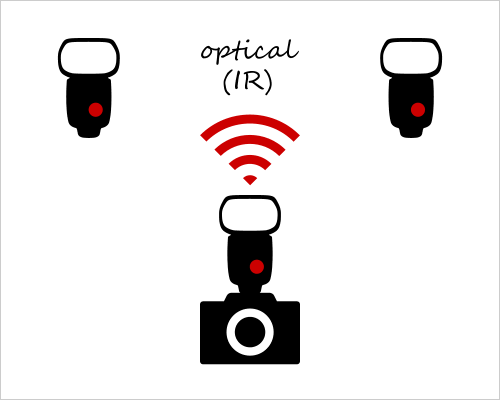
This is unfortunately an expensive option equally you pretty much have an on-photographic camera flash unit beingness used solely as a transmitter unless you plan to bounce the on-camera flash. It'south fabricated worse for Canon owners equally only the top-end Speedlites (500 and 600 series) can be "Chief" flashes.
For Nikon, there are many flash units that tin exist the "Commander" of "Remote" flashes in the wireless setup, these include the SB-400 (very limited), SB-700, SB-800, SB-900 and SB-910.
UPDATE September xiv, 2012: Joe McNally's video also demonstrated a examination using a SB-900 on a Nikon D800 in vivid sunlight and he was able to trigger another SB-900 from 200 anxiety away! The on-camera SB900 had to be zoomed to 200mm to give it some assist. That was likewise quite impressive. Once again, if y'all have ii flashes to fire and tin't do perfect line-of-sight, you can await that distance to be decreased.
To save a fleck of money, Catechism and Nikon also offer a wireless flash trigger to put on your photographic camera and then you can avoid buying a total flash-unit. These special transmitters are still optical as they also make utilize of infrared (IR) signals.
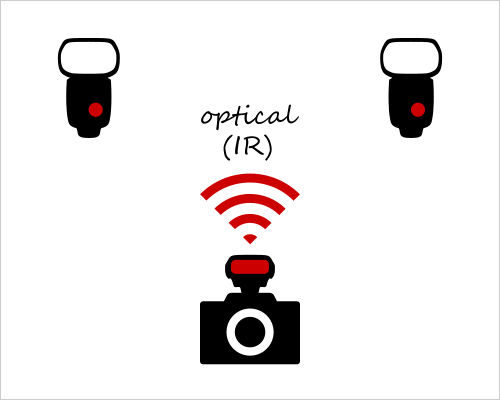
For Canon, the dedicated transmitter is chosen the ST-E2 (B&H). For Nikon, the equivalent is the SU-800.

If y'all're planning to accept advantage of the new radio-based triggering included in the 600EX-RT, Catechism has released a dedicated transmitter called the ST-E3-RT (shown higher up) which will set you back U.s.a.$320.
UPDATE September 14, 2012: In the same Joe McNally video mentioned higher up, he tested the SU-800 on a Nikon D800 in bright sunlight and was able to trigger another SB-900 from only 65 feet away. That was less impressive for certain.
Option 3: TTL Cable + Flash-to-Flash Wireless Trigger
I of the simplest and more affordable options for moving a unmarried camera off-photographic camera is to utilise a special cablevision that effectively moves your on-camera flash shoe to some other location. This is known as an TTL cable as information technology offers 100% allegiance in the communications between the camera and flash. The cable simulates the flash sitting on the camera (it literally doesn't know it'southward off the camera).
TTL cables come in various lengths and they're either straight or coiled. Unless you programme to limit your off-camera use to an arm's length, Exercise NOT buy a coiled cable. They might say they're six feet long simply when coiled it'south looks like 2 feet. If you pull hard plenty it will catapult your off-camera wink to the basis!
Don't feel compelled to buy a proper name-brand cable by your camera make either. There'southward enough of cheap alternatives that can be had for 1/10th the price and there's some DIY options for extending cables with sample RJ-45 wires. You can likewise look at OCF Gear as it's recommended by Syl Loonshit, a Canon Speedlite (sentinel his contempo workshop). B&H sells a diversity of long cables as well such as this 33' Vello E-TTL cable for US$50.
So far, this isn't all the same a wireless choice. It becomes a wireless pick once y'all innovate more flashes to this setup and your main flash unit is i that can act as a main/commander (as described in Option 2). Yous attach the primary flash to the TTL cable and then have it remotely control the others in your setup (see Option 2 for details).
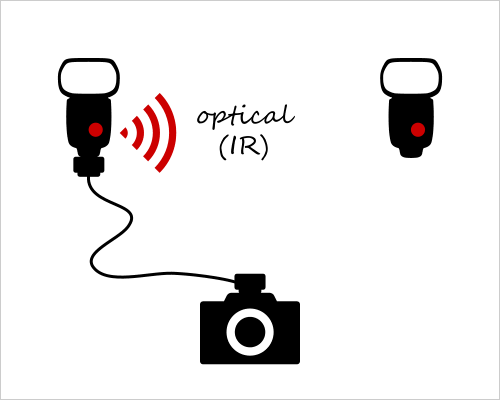
Choice 4: Sync Cable + Optical Slave Trigger
If you don't take newer flashes that can speak to each other or you'd like to buy inexpensive third-party manual flashes, there is some other option that's similar to Choice 3 but it's can only trigger a wink with transmission ability settings (i.e. no TTL communication). In this case, when the corded wink is fired, another flash paired with a light sensor (photodetector) sees that and fires at the same time.
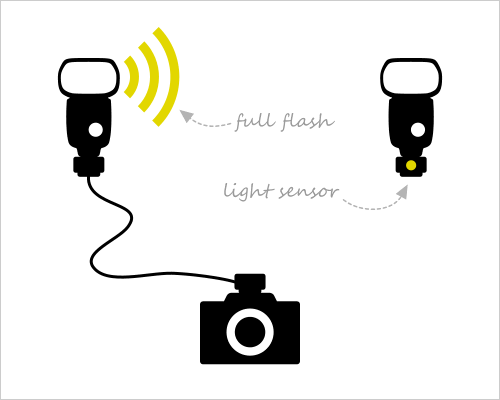
These sensors are referred to as Optical Slaver Triggers. In fact, near studio probes have these built in but they're lacking in speedlights. Luckily you can buy a wink shoe that has an optical sensor congenital-in (as shown below) and use with with Whatever flash of Whatever make.
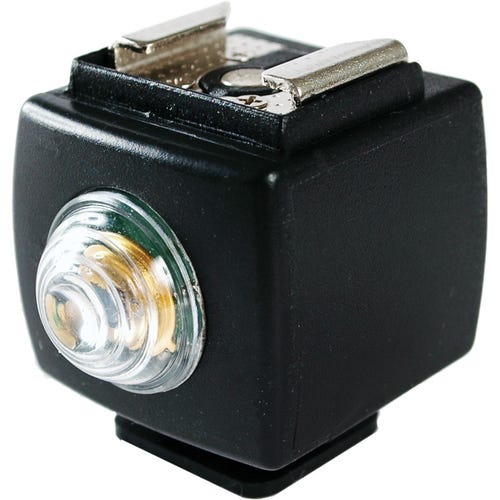
The important thing to note is you can't use optical triggers with TTL flash metering. The pre-wink that fires as function of TTL communication will "trip" the optical sensor too early on. You can nonetheless use a TTL cablevision but yous'll need to have the corded flash prepare to a manual power setting. I've read that even the infrared bespeak from flash transmitter can fool some optical triggers to fire likewise early on so watch out for that.
Since yous don't need TTL in for this option, you can optionally skip the TTL cable in favor of a cheaper cable called a "PC Sync Cord" that fits into a "PC Socket". Cheque that your camera has a PC Socket of course. Y'all can detect many inexpensive flash units that a PC socket but if they lack information technology, you can purchase an inexpensive wink shoe with the socket for about $10 to $30 (run across below for the Vello adapter optimized for Canon and Nikon).

Beyond the lack of TTL, the big downside of this option is that y'all demand line of sight to ensure the optical eye sees the burst of calorie-free from the corded wink. In vivid daylight, it might fail you as information technology tin can launder out the lite bespeak. And finally, anyone else's flash tin trigger your optical slave which could be quite annoying in some situations.
Option v: Radio-Trigger of Manual Wink
If the optical options above don't appeal to you, you can nonetheless get wireless via radio-waves. At that place are many tertiary-party wink triggers that are radio-based and exercise a simple function really well — they tell your flash to "fire!". At that place's no tw0-way advice, just the command to wink. Your wink must therefore exist on a transmission power setting (i.e. no TTL again).

Radio-based triggers are far superior to the optical options every bit line of sight is not required. Even in bright sunlight the signal will exist delivered 10x further (over 300 feet). Since they get through wall, you tin tuck your flash in hidden places you'd never think of to pull off really unique and artistic shots (e.yard. you could illuminate a fireplace from the inside every bit if the fire was raging).
If yous're just real-estate photography, y'all could put a wink unit in a afar room to have it lite up a nighttime corner of your photo. In that location would be no concern about the flash firing and doing and so consistently.
For this to office, y'all put a radio transmitter on your camera's hot shoe and adhere a radio receiver on the flash unit of measurement. You'll need to set the flash ability on the wink unit itself every bit there'south not real communication between the camera and flash units. This can be annoying if you take several flashes in awkward positions (east.one thousand. high on a nail).
It's recommended that y'all invest in a light meter to save time calculating the right exposure and measure relative power from multiple flashes. Information technology still work without a wink meter, you just take to do more trial and error.
This option can be relatively cheap only yous tin can spend real money on premium triggers if you like. The most famous and "professional person" triggers are considered those by PocketWizard. The most PocketWizard series is the "Plus Ii" and the new "Plus 3" (available March 15, 2012). The new version is cheaper than information technology's predecessor but it will still retail for Us$140 each. You'll need 1 for your camera and one per flash. For a two calorie-free setup, that'south a whopping US$420 over and above the cost of your flashes.
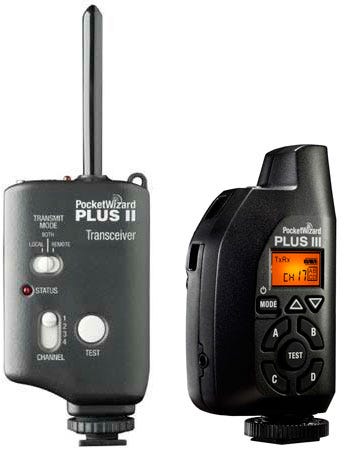
When shopping, don't be confused by the term "transceiver". It only means as each unit of measurement tin can send and receive the radio signals instead of having a dedicated transmitter and receiver The big benefit of transceivers is you lot're not at run a risk of having getting stuck when your but transmitter breaks (assuming y'all accept more transceivers available).
Update March 1, 2013: PocketWizard has merely released a simpler and more than affordable flash trigger called the "PlusX". Information technology'southward only $99 per transceiver and is uniform with all other PocketWizards.
Luckily there are a number of other companies creating "manual" radio-based flash triggers. There's too many to listing here only many of my friends trust Cactus brand triggers by Harvest One. Most have the "v4" transmitter/receivers but there is a new"v5" line of transceiver that operate in the ii.4 GHz band. Check out the comparative review past Karel Donk (the photograph below is from his review).
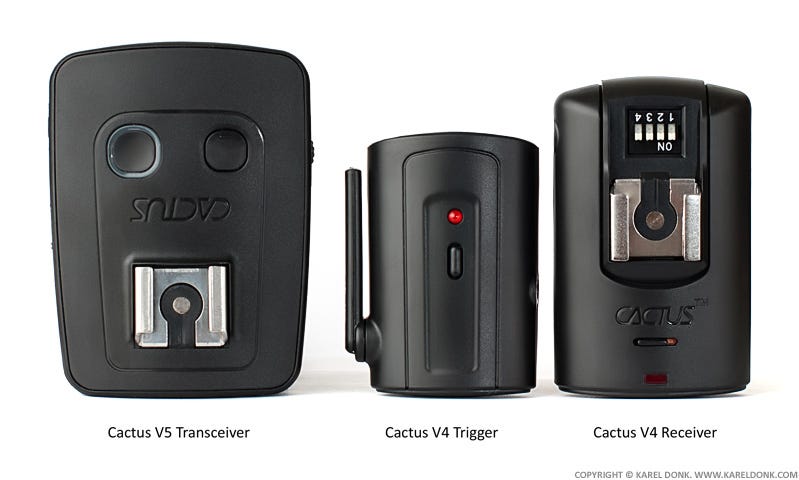
Cactus v5 units retail for US$threescore/CAD$100 for a pair and Usa$35/ CAD$lx for each extra transceiver. A two-light setup will therefore gear up you back only United states of america$125 / CAD$160. Non bad. If you tin't find Cactus triggers, you can also look at other very cheap options like the Yongnuo RF-603.
Option 6: Radio-Trigger with TTL Back up
The dream scenario is of form radio-based triggering while maintaining a full TTL communication to your camera. This would replicate all the benefits of Pick 1 but without the drawbacks of an optical organization.
Every bit mentioned in Option 1, Canon has made a big step recently toward radio-based triggering with the introduction of the 600EX-RT flash and the ST-E3-RT transmitter. This would non be the well-nigh affordable option only you could "discount" the wink's hefty US$630 price tag by the toll of a TTL-capable radio trigger you don't take to buy. For the balance of united states of america, those with an existing investment in flashes, nosotros must await for other options.
TTL communication is photographic camera make specific and and so are the triggers. With such triggers, you can do good from E-TTL / i-TTL flash metering and total on-photographic camera command of your flashes. Even when you opt to use transmission flash power settings, you lot can control those settings from your photographic camera. That's a huge benefit.
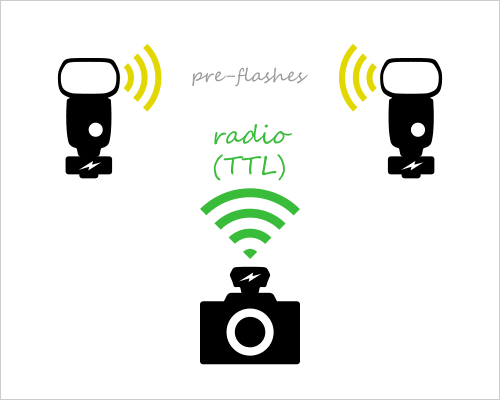
PocketWizard plays in this arena with a line called "Flex TT5". Units exist for Catechism and for Nikon and they're certainly not cheap. A Flex TT5 transceiver will prepare y'all back virtually US$220. A 2-light setup will therefore run yous at least US$660.
Another popular but expensive option is the RadioPopper system. This system is unique as information technology captures the optical transmissions from Canon and Nikon cameras and sends them via radio waves to the wink. The RadioPopper units on the flashes re-convert the radio waves back to light signals. Run across the RadioPopper PX review by Ed Zawadski (the photo below is from his review).
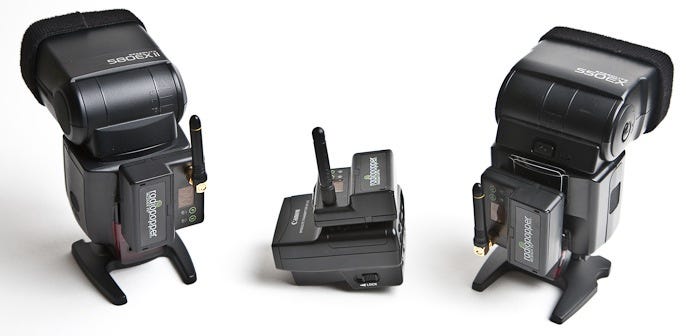
RadioPoppers are an interesting arrangement merely at US$250 for a transmitter or receiver, a 2 low-cal setup will run you $750. That'south fifty-fifty more than than the PocketWizard with a lot more work to get going. Yous can't, for example, motion the RadioPopper to other wink units easily as in that location'south a setup required to stick the unit over the flash'southward light sensor.
Luckily there are some Chinese manufacturers making a couple TTL-compatible units. One company called Pixel has ii makes, ane called "Knight" and 1 called "Rex". From what I understand, the King units are less expensive and run on simple AA batteries vs. a apartment battery. The King line merely exists for Canon TTL at the moment all the same.
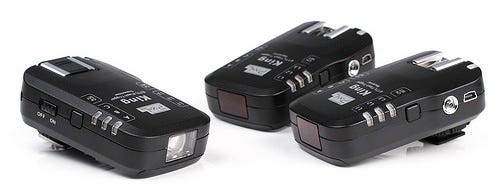
A Pixel King pair can be establish for merely The states/CAD$150. Sets exist with two receivers for but US/CAD$240. That'southward over $400 saved compared to PocketWizard TT5.
UPDATE: One downside of the Pixel King is that it lacks support for ratio-based lighting setups over TTL. You can prepare relative ability of each group (A, B and C) just you tin't simply select "2:1" for groups "A:B" to become twice every bit much low-cal from A than B. For me, this is inconvenient simply something I can live without given the cost savings over alternatives.
UPDATE May 25, 2012: My full review of the Pixel Rex E-TTL Wink Trigger is at present bachelor.
UPDATE September nineteen, 2014: In that location is a total range of radio-based TTL-compatible triggers by Phottix that is called Odin. You can now purchase Phottix products at B&H. They're available for Canon, Nikon and Sony and a two-wink set (1 transmitter and 2 receivers) sells for $400. The Odin transmitter looks especially easy to employ. There is also the Phottix Mitros to consider which is an on-photographic camera flash that has a built-in Odin transceiver (sends and receives the Odin radio signals in improver the IR signals). The Mitros tin can exist used off-photographic camera and retails for $400 with a decent of guide number of 58m/190' (equivalent to the Canon 580EX Two). Read dpreview.com'south review of the Mitros if you want to learn about the flash's functioning and usability. If I had to buy again, I'd probably buy into the Odin system.
Bonus Option: Manual Flash Triggering
Although it is a fringe option, I thought it'd be worth pointing out that yous tin physically trigger whatsoever off-photographic camera flash on your own… yep, with your hand. Only find the flash unit's "Pilot" or test-fire button. This is a cheap and no-tech solution.
Naturally, you can't react in 1/8000th second merely yous can certainly exercise quite a bit if your exposure fourth dimension is long (e.1000. couple seconds or longer). This technique is therefore well suited to night photography.

Not only can you pop-your flash manually, y'all can practice so many times during a single exposure to simulate many flash units. This is often referred to every bit flash painting.
See my post about a Nighttime Photography for a great video and some examples of my own work using this technique.
Conclusion
Later on a couple years of using Catechism's built-in optical arrangement (option 1), I longed for a radio-based TTL solution (option 6) if I could afford information technology.
Turned out that Pixel King was the nearly logical option for me given the alternatives. And so, just a couple weeks ago, I purchased a Pixel King set with i transmitter and two receivers for $238 from a small shop in Montreal (that's half-priced compared to Henrys so exercise shop around). So far, they work as advertised.
UPDATE May 25, 2012: My full Pixel King review is now bachelor.
UPDATE September nineteen, 2014: Every bit I said a above, the Phottix Odin and Mitros flashes are a radio-based system that is quite highly-seasoned. It'southward probably what I'd purchase into now if I lost everything I owned now.
In the finish, what practise y'all think of the options equally I've presented them? What take you done or might you lot practice and why?
More than Reading
- March 15, 2012: Adorama posted an article, "The Aureate Age of Wireless Photo Flash"
Source: https://learningdslr.com/six-ways-to-go-wireless-with-your-flash-b4057822773
Posted by: humphreyhunty1956.blogspot.com

0 Response to "How To Trigger Flash Off Camera"
Post a Comment